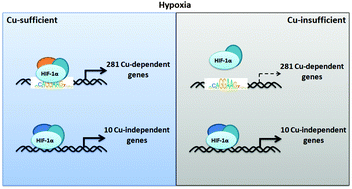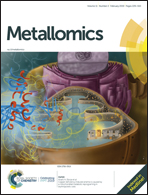Copper affects the binding of HIF-1α to the critical motifs of its target genes†
Abstract
Copper (Cu) regulates hypoxia-inducible factor-1 (HIF-1) transcription activity by affecting the selectivity of HIF-1α binding to the promoters of affected genes. In hypoxia, Cu is required for HIF-1α binding to the promoter of BCL2/adenovirus E1B 19 kDa protein-interacting protein 3 (BNIP3), but the metal does not affect the binding of HIF-1α to the promoter of insulin-like growth factor 2 (IGF2). Here, we made an effort to provide a comprehensive understanding of Cu regulation of the selectivity of HIF-1α binding across the genome. We used tetraethylenepentamine (TEPA), a Cu selective chelator, to reduce Cu content in the cells. We conducted chromatin immunoprecipitation combined with massively parallel DNA sequencing (ChIP-seq) to globally map the binding sites of HIF-1α, RNA polymerase II (Pol II), and the acetylation at the 27th lysine residue of the histone H3 protein (H3K27ac). We also performed RNA-sequencing (RNA-seq) in EA.hy926 cells under hypoxia (1% O2) with or without Cu depression to determine the profile of mRNA expression. Our analyses identified 3197 HIF-1α binding sites under hypoxia. Cu depression by TEPA reduced the number of binding sites to 1820 from the original 3197, but induced 274 new binding sites. We analysed these binding sites in the promoter and putative enhancer regions, coupled with their mRNA expression profiles, and found 281 Cu-dependent and 10 Cu-independent HIF-1α target genes. We found that the core bases “GGAA” and “TTCC” constituted the critical motifs for the binding sites of Cu-dependent genes. This study thus revealed that Cu, by affecting the binding of HIF-1α to the critical motifs in the promoter and putative enhancer regions of HIF-1 regulated genes, leads to the selectivity of HIF-1 regulated expression of Cu-dependent genes.



 Please wait while we load your content...
Please wait while we load your content...